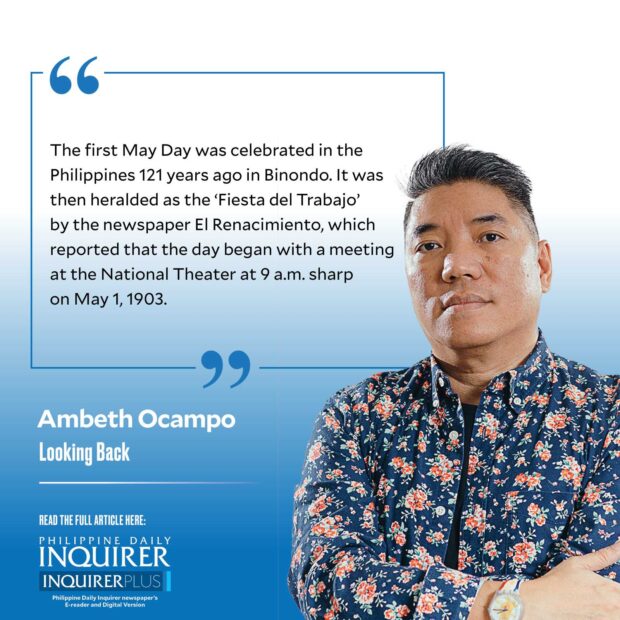
May Day is Labor Day to many. It is International Workers’ Day. It is “Araw ng Mangagawa,” an annual holiday legislated for the Philippines since 1908. It is also a church feast commemorating St. Joseph the Worker. It also reminds me of the international distress signal “May Day,” which actually comes from the French “m’aidez” (help me). Then, of course, there is Nick Joaquin’s classic short story “May Day Eve,” which I first read for a freshman English class. Unlike K-12 literature classes, we were not asked for the plot, the main characters, not even the so-called “moral of the story.” In that memorable writing class, I learned to appreciate Joaquin’s shameless display of genius and style because from 1947, when it was first published, the opening paragraph of the story had the record of being the longest sentence in Philippine literature. That title has since been wrested from Joaquin by Krip Yuson’s kilometric, stream-of-consciousness sentence in “Great Philippine Jungle Energy Café” (1988), but Joaquin’s remains a literary marvel.
The first May Day was celebrated in the Philippines 121 years ago in Binondo. It was then heralded as the “Fiesta del Trabajo” by the newspaper El Renacimiento, which had a report on the festivities organized by the Union Obrera Democratica Filipina. Isabelo de los Reyes, founder of the Union, was arrested in August 1902 and charged with sedition as well as “conspiracy to raise the price of labor” so he was succeeded by Dr. Dominador Gomez who figured prominently in the celebration of the first Labor Day in 1903.
El Renacimiento reported that the day began with a meeting at the National Theater at 9 a.m. sharp on May 1, 1903. In a setting adorned with anahaw leaves, tropical plants, and American flags, Gomez opened the program and was followed by Manuel Artigas y Cuerva who served as “toastmaster.” Lope K. Santos delivered a speech in Tagalog proclaiming the force of the Union Obrera Democratica Filipina followed by Ignacio Francisco who spoke in Spanish, then Felix Victoriano and Liboro Gomez who both delivered their orations in Tagalog. Hermenegildo Cruz, representing the Writers Guild, presented the Union president with a magnificent objet d’art accepted by Gomez with an eloquent, magisterial, and brilliant speech. This program ended with the Philippine and American anthems.
In the afternoon, people had spilled into the Plaza de Binondo which was too small to accommodate the multitude who came to attend a rally scheduled for 3 o’clock sharp. A march led by the Departamento de Obreros de Cavite commenced with everyone following the seven flags representing all the guilds in the province. The Caviteños were followed by the Guild of Silversmiths (gremio de plateros) carrying a flag, and a lantern in the form of a triangle with an eye in the center. Committees from Paco, Pasay, San Juan del Monte, Tambobong (now Malabon), Caloocan, Bocaue, and Sampaloc, preceded the Gremios de tabaqueros or Tobacconist Guilds of the various cigar factories in Manila. They were followed by the guilds of other professions: barbers, tailors, coachmen, the Kapisanan Magdaragat, artists, and machinists.
The Damas de San Nicolas were in a car carrying a huge satin flag with the inscription ”Union Obrera Democratica” embroidered with gold thread. Committees from Tondo and Malate came with a tricolor flag. Ermita had a carroza artistically adorned with coconut palms, anahaw, and the instruments of work. On it was a white flag painted with an allegory. Lithographers, printers, and binders guilds presented a magnificent bust of Gutenberg on a carroza that had the names of heroes from their history: fray Francisco de San Jose, Juan de Vera, Tomas Pinpin, Francisco Diaz Puertas, Celestino Miralles, and Jorge Oppel. The same guild had a second carroza pulled by four horses carrying portraits of Isabelo de los Reyes and Dominador Gomez together with an allegorical sculpture flanked by four columns covered with American flags
Last were guilds of carriage makers, painters, and hat-makers, and the committees of Santa Ana, Santa Cruz, as well as subcomittees of cigar factories: Maria Cristina, Germinal, Hensiana, Orienta, and Alhambra. Cars driven by attractive women and workers’ families represented the Gagalangin committee. Then as now, Malacañang was closed to the workers who wanted to present their message before the United States chief executive. Union Obrera president Gomez then read the message aloud by one of the principal palace gates, his speech capped by the “Marchas Filipina y Americana” played by a band. The procession traveled to Santa Mesa via Uli-uli to end the day at special races organized by the Santa Mesa Club as a tribute to work. At 7 p.m., the provincial association gathered in the Teatro Nacional where they were served an abundant “lunch” at 8 p.m. followed by a velada with patriotic speeches, songs, and dances: rigodones, valses, and the two-step. A good time was had with sweets and beers by all 20,000 people who participated that May Day in 1903.
Workers’ rights were demanded differently then from the strikes and rallies of today.
—————-
Comments are welcome at aocampo@ateneo.edu